Complexes of artillery intelligence family "Zoo"
1L219 Zoo
The development of the radar artillery reconnaissance complex 1Л219 "Zoo" began in accordance with the decision of the Council of Ministers of the USSR on July 5 1981. The new radar was designed to replace existing types of equipment, primarily the 1RL239 “Lynx” complex, which was actively used by the troops. The head developer of the project was assigned to the Strela Research Institute (the city of Tula), V.I. Simachev. Also several other organizations were involved in the work. For example, NPP "Istok" (Fryazino) was responsible for the development of microwave equipment, and the Tula plant "Arsenal" was to build prototypes of the finished complex.
It should be noted that one decision of the Council of Ministers required the creation of two artillery reconnaissance complexes at once. The Zoo-1 and Zoo-2 systems should have different characteristics and different components. At the same time, the maximum possible unification of two types of equipment was implied.
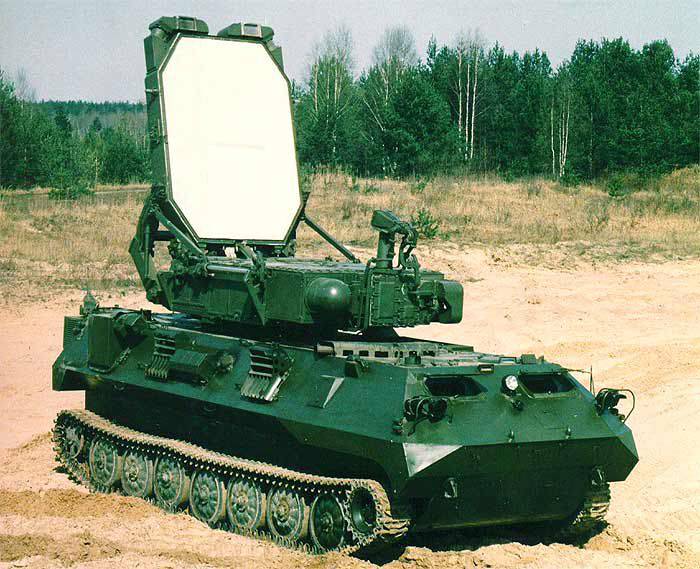
Self-propelled radar 1L219 "Zoo-1"
The development of a new project at a certain stage encountered some difficulties, which led to a shift in the timing of the implementation of different phases. Thus, a draft version of the project 1Л219 "Zoo" was completed in two years: it was ready in 1983. The following year, a technical version of the project was prepared. In 1986, the organizations involved in the project completed all the work on the preparation of design documentation, but the start of construction of experimental reconnaissance complexes was postponed due to the changed customer requirements.
19 June 1986, the Council of Ministers issued a new decree, determining the further development of radar reconnaissance systems for artillery. The military wanted to get not only a self-propelled machine with a set of electronic equipment, but also a number of other means. In accordance with the new decree, it was necessary to develop a new set of facilities into which the Zoo machine was to enter. Due to changes in customer requirements, project developers had to re-develop some elements of the complex. Alteration has undergone part of electronic equipment, including means of detecting targets.
Due to numerous improvements, the construction of the Zoo prototype machine has been delayed. She was able to release for preliminary tests only in 1988 year. This phase of inspections, accompanied by various modifications, continued until the spring of 1990, when several prototypes were presented for state tests. During the year, the equipment was tested in the ground forces of several military districts. During these events, all the necessary information about the operation of the complex under the conditions of the combat units was collected.
In the course of all tests, the calculated characteristics of the complex were confirmed and the advantages over the existing “Lynx” system were revealed. In particular, the range was increased by 10%, the field of view was doubled, and the throughput of automation - by 10 times. According to the results of state tests, the radar artillery reconnaissance complex 1Л219 "Zoo-1" was adopted. The corresponding command order was signed on 18 on April 1992 of the year.
The Zoo-1 reconnaissance complex was designed to monitor the specified areas, monitor enemy artillery and monitor the results of firing of their batteries. In order to ensure the possibility of combat work on the same positions with artillery, all the equipment of the complex was mounted on a self-propelled chassis. The MT-LBU universal tractor was chosen as the basis for the complex. When the combat weight of the machine is of the order of 16,1 t, the maximum speed at the level of 60-62 km / h is ensured. Management of all the facilities of the complex is carried out by the calculation of three people.
An antenna post, made in the form of a turntable with a phased antenna array mounted on it, is mounted on the roof of the base chassis. In the stowed position, the antenna is lowered to a horizontal position, and the entire post is rotated along the body of the machine. The antenna array is part of a three-coordinate radar station and allows you to monitor a sector up to 60 ° in azimuth. The viewing angle of elevation is around 40 °. The ability to rotate the antenna post allows you to change the surveillance sector without moving the entire machine.
Radar complex 1L219 operates in the centimeter range and is controlled by onboard digital computers such as "Electronics-81B" and "Saver-2". All operations for tracking the specified sector, detecting targets and issuing the processed information are performed automatically. The calculation of the complex has the ability to monitor the systems and, if necessary, intervene in their work. To display information about the situation in the workplace of the commander and the operator provides black and white screens on the CRT.
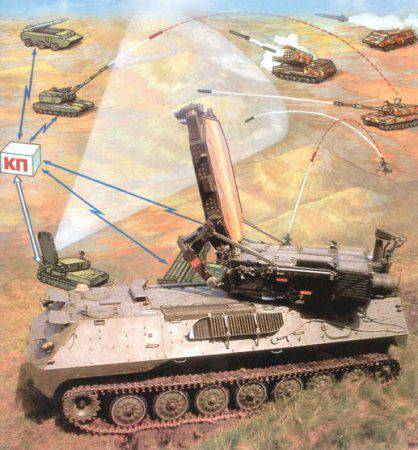
1L219 system operation scheme
The main task of the 1L219 “Zoo-1” reconnaissance complex was to detect the positions of the rocket forces and artillery of the enemy, as well as to calculate the trajectories of the projectiles. In addition, it was possible to control the shooting of their artillery. The main method of determining the coordinates and trajectories was tracking small-sized high-speed ballistic targets - projectiles. The station was supposed to automatically monitor the shells, calculate their trajectories and determine the location of the guns or launchers.
The automation of the Zoo-1 complex is capable of detecting at least 10 enemy fire positions in a minute. At the same time, no more than 4 targets are maintained. The probability of determining the position of the weapon in the first shot was determined at the level of 80%. During the combat operation, the complex was to determine the current parameters of the flying projectile, as well as calculate its full trajectory over a known segment. After that, the automation issued information about the place of launch of the projectile at the command post. Further, this information should be transferred to the artillery to strike back at the enemy’s firing position in order to destroy his equipment and weapons. To determine its own position, used in determining the coordinates of the targets, the 1Т130М “Beacon-2” topogeodesic reference system is used.
Serial production of self-propelled radar artillery reconnaissance complexes 1Л219 "Zoo-1" was entrusted to the enterprise "Vector" (Ekaterinburg). Initially it was assumed that the 1L219 complexes would be used in the missile forces and artillery at the regimental level. Each regiment and brigade had to have its own systems of this type, designed to monitor enemy artillery and issue coordinates for the counter battery.
However, the collapse of the Soviet Union did not allow to fully implement all the available plans in a short time. Serial construction of machines "Zoo-1" was conducted at a relatively slow pace, but in recent years, ground forces have managed to get some of such equipment. All stations 1Л219 are used in the control system of artillery formations and successfully solve the tasks assigned to them.
1L220 Zoo 2
Resolution of the Council of Ministers on July 5 1981, required to develop two radar reconnaissance complex. The first, 1Л219, was created by the Strela Research Institute in Tula in collaboration with some other enterprises. The development of the second complex with the designation 1Л220 was entrusted to NPO Iskra (Zaporozhye). The task of the second project was to create another intelligence complex with an increased detection range. The rest of the goals and objectives of the projects were the same.
Within the framework of the Zoo-2 project, a complex of electronic equipment was developed, suitable for mounting on various chassis. It was planned to offer the customer two modifications of the intelligence system at once, mounted on different chassis. There was a project of the machine on the basis of the GM-5951 tracked chassis and the KrAZ-63221 wheeled. The wheel complex received its own designation 1L220U-KS. In the case of a tracked chassis, the electronic equipment was located inside a light-armored hull, on the roof of which a rotary antenna post was installed. The wheeled vehicle design implied the use of a box body with the appropriate equipment.
According to the general architecture, the “Zaporozhye” version of the complex resembled the development machine of Tula specialists. The 1Л220 complex was proposed to be equipped with a radar with a phased antenna array mounted on a swivel base. Working in the centimeter range, the station was supposed to produce the detection of flying artillery shells.
The electronics of the Zoo-2 complex made it possible to automatically monitor the situation, search for targets and determine their trajectories, at the same time calculating the location of enemy guns.
After the collapse of the USSR, the enterprises engaged in the Zoo program remained in different countries, which led to a serious difficulty in working. Despite all the problems, NPO Iskra continued to work and completed the creation of a new artillery reconnaissance complex. Due to some problems, the project had to be further refined. The updated version of the project received the designation 1L220U.
Due to the country's economic problems, the need to refine the project, etc. tests of the prototype system "Zoo-2" began only in the late nineties. According to the results of tests, the system in 2003 was adopted by the Ukrainian army. Subsequently, Ukrainian enterprises in cooperation with foreign organizations built a certain amount of such equipment supplied to the armed forces.
According to available data, due to improvements in radio-electronic equipment, it was possible to significantly improve the performance of the 1Л220У complex in comparison with the “Tula” 1Л219. The machine station of Ukrainian development is able to follow the sector width 60 ° in azimuth. Radar can detect tactical missiles at ranges up to 80 km. When an enemy uses multiple launch rocket systems, the maximum detection range, depending on the type of missile, is 50 km. Mortar mines caliber to 120 mm station notices at distances up to 30 km. Declared the ability to detect enemy firing positions per minute before 50.
1L219М Zoo-1
In the early nineties, the research institute Strela began the development of a modernized version of the Zoo-1 complex. The updated version of the complex received an index 1Л219М. In some sources there are various additional designations of this complex, in particular, sometimes the name “Zoo-1M” appears. However, this “name” was later assigned to another family complex.
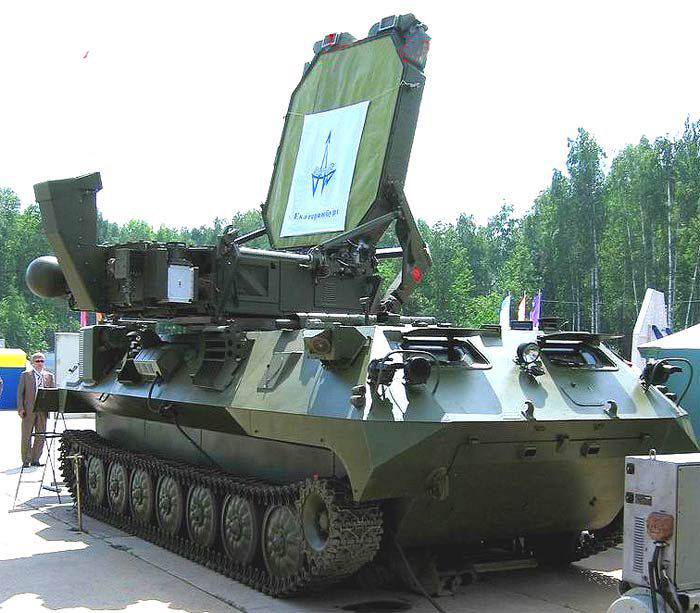
Machine 1Л219М "Zoo-1". Photo Pvo.guns.ru
The goal of the 1Л219М project was the replacement of obsolete equipment with new and enhanced features. For example, the replacement of the CABM was made. In the updated complex, computer control of the Baguette family is used to control the operation of automation. In addition, a new topographic-geodetic binding system was used in the modernization project. To accurately determine its own coordinates, the upgraded Zoo-1 machine has received the 1Т215М topregiver and the GLONASS receiver.
According to the developer, in the project 1Л219М it was possible to significantly improve the characteristics of the radar station. Thus, the detection range of operational-tactical missiles was increased to 45 km. The maximum detection range of missiles increased to 20 km. When an adversary uses mortars of caliber 81-120 mm, it is possible to determine the firing position at ranges up to 20-22 km.
The automation complex 1Л219М is capable of processing up to 70 targets per minute. Up to 12 objects are simultaneously accompanied. For automatic calculation of the full trajectory of enemy ammunition with the definition of a launch point and a drop point, no more than 15-20 are required. C.
In addition to the radar equipment, the calculation jobs have been upgraded. The main innovation was the use of color monitors, which display all the information about the situation in the station's sector of responsibility. All information about the enemy’s firing positions found is automatically transmitted to the command post and can then be used to strike back.
The development of the project 1Л219М “Zoo-1” was completed in the mid-nineties. Soon after, the prototype tests started. According to some sources, during the tests, numerous shortcomings were identified, primarily related to the reliability of various units. Consequently, it was decided to modify the system in order to improve the characteristics that do not meet the requirements.
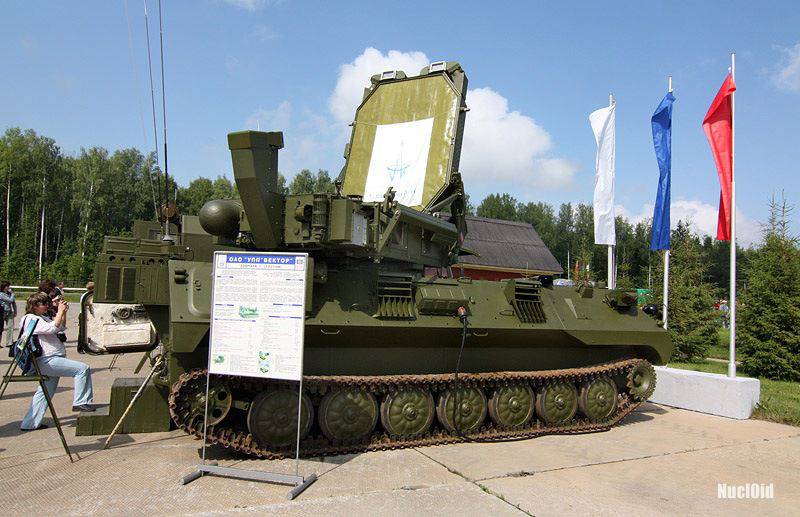
Machine 1Л219М "Zoo-1". Photo Ru-armor.livejournal.com
Exact information on the production and operation of complexes 1Л219М is not available. Some sources mention the construction of such equipment and even its use in some recent conflicts. However, full evidence of this is missing. It was probably decided not to start mass production of new equipment due to the lack of serious advantages over the existing one, as well as due to the difficult economic situation of the armed forces. Nevertheless, the Zoo-1 complex in the updated version was demonstrated at various exhibitions.
1L260 Zoo-1М
The latest at the moment complex artillery intelligence family "Zoo" is a system with an index 1Л260, created in the two thousandth years. After a not too successful project 1Л219М, the Tula research institute Strela continued to work on the creation of new radar stations for ground forces. To date, the Strela enterprise has received the status of a research and production association and became part of the Almaz-Antey Air Defense Concern.
The complex "Zoo-1M", despite the name, is not a modernized version of the existing technology, but a completely new development. For example, the new complex has several components at once that perform various functions. The main element of the complex is a self-propelled radar 1Л261 on tracked chassis. In addition, the 1Х38 maintenance machine and a backup power station are involved in the combat operation. Auxiliary elements of the complex are mounted on car chassis. According to some information, the self-propelled radar can, if necessary, perform the assigned tasks independently and without the help of additional elements of the complex.
Self-propelled radar 1Л261 differs from its predecessors in a different layout of the main units. As before, all units of the machine are mounted on a tracked chassis, which is used as the machine GM-5955. An antenna post with lifting and rotating mechanisms is mounted on the roof of the case. In the stowed position, the phased array antenna is placed on the middle and aft part of the hull cover. The combat weight of the machine exceeds 38 t. The work of all systems is controlled by the calculation of three people.
During the preparation of the complex for operation, the antenna rises and can rotate around the vertical axis, changing the viewing sector. The design of a phased array antenna allows the calculation of the station to follow the objects located in the sector of 90 ° in azimuth. The exact characteristics of the target detection range have not yet been announced. According to previously published data, the 1L261 station is able to determine the firing position of enemy artillery with an error up to 40 m. When calculating the launch point of missiles of multiple salvo systems, the error is 55 m, the launch point of ballistic missiles is 90 m.
Exact information about the current status of the project 1L260 "Zoo-1M" is not available. According to some reports, a few years ago, the Russian Ministry of Defense ordered a number of such complexes, but the details of the contract were not announced. In addition, in 2013, one of the tests of the complex could be carried out. Official information about the complex "Zoo-1M" and its prospects have not yet been published.
On the materials of the sites:
http://bastion-karpenko.ru/
http://npostrela.com/
http://tvzvezda.ru/
http://rg.ru/
http://bmpd.livejournal.com/
http://militaryrussia.ru/blog/topic-513.html
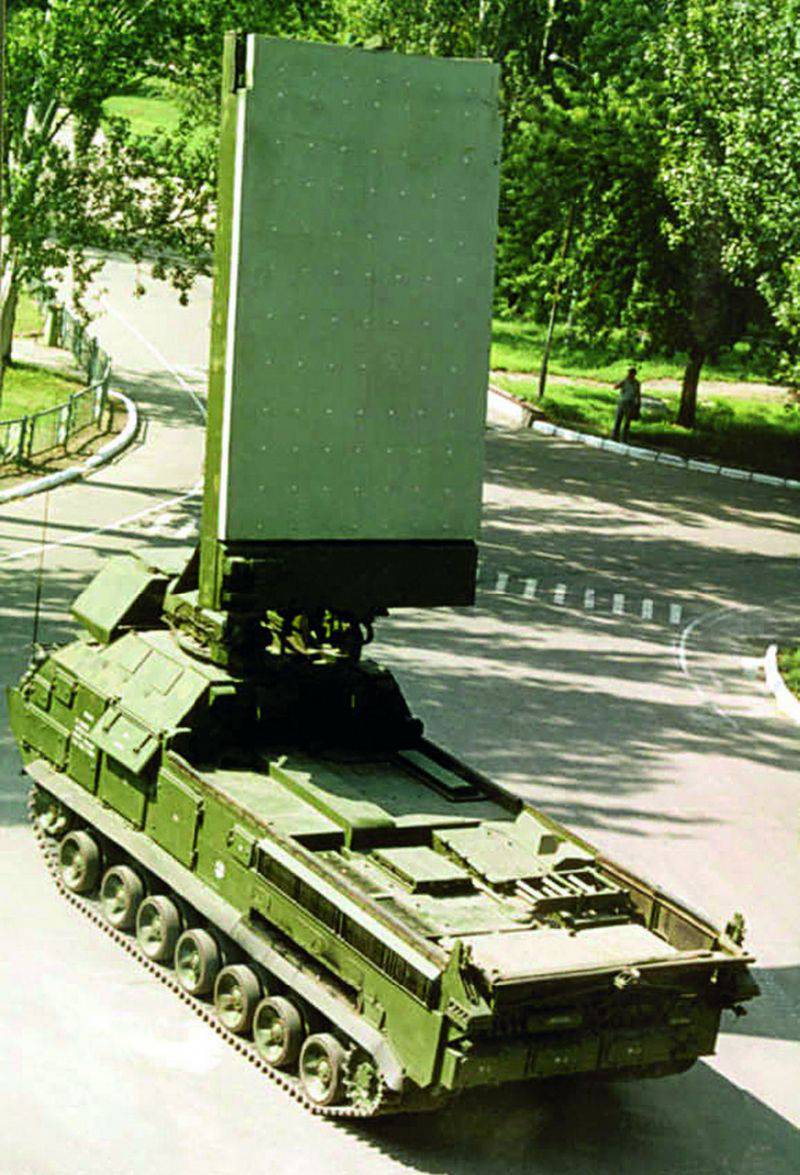
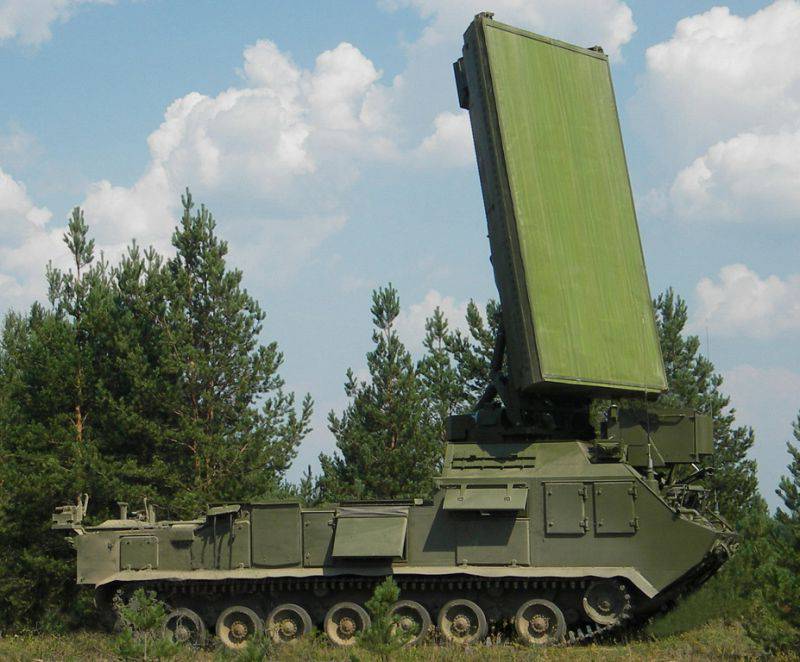
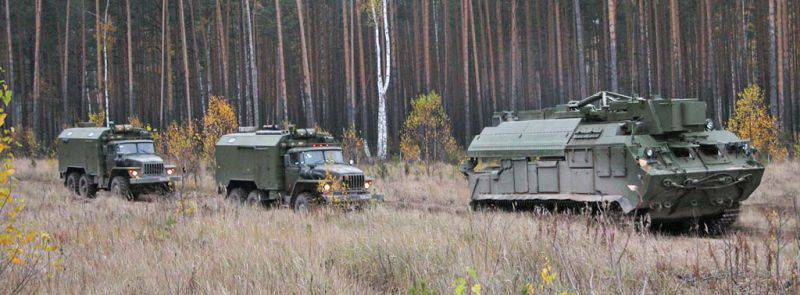
Information